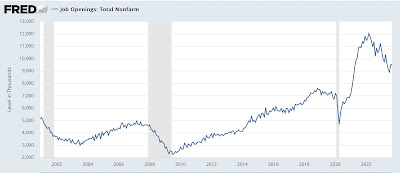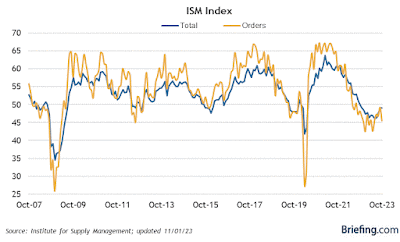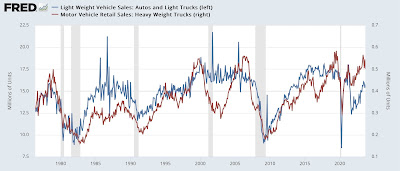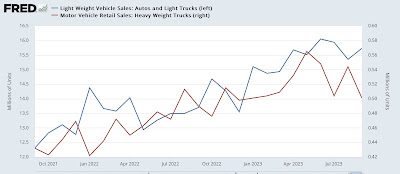The new month of data begins: residential construction positive, job openings negative, and manufacturing mixed – by New Deal democrat As usual, the monthly data started out with reports on the two most important production sectors of the economy, namely manufacturing (for October) and construction (for September). Additionally, the JOLTS jobs survey for September was released. I am going to do more detailed reports on both JOLTS and construction later today or tomorrow. For now, let me just make a couple of drive-by comments. The most important segment of the JOLTS report right now are job openings, because they will tell us how much upward pressure remains in the jobs market due to employers being unable to fill vacant positions. And
Topics:
NewDealdemocrat considers the following as important: Hot Topics, politics, US EConomics
This could be interesting, too:
Robert Skidelsky writes Lord Skidelsky to ask His Majesty’s Government what is their policy with regard to the Ukraine war following the new policy of the government of the United States of America.
NewDealdemocrat writes JOLTS revisions from Yesterday’s Report
Joel Eissenberg writes No Invading Allies Act
Ken Melvin writes A Developed Taste
The new month of data begins: residential construction positive, job openings negative, and manufacturing mixed
– by New Deal democrat
As usual, the monthly data started out with reports on the two most important production sectors of the economy, namely manufacturing (for October) and construction (for September). Additionally, the JOLTS jobs survey for September was released.
I am going to do more detailed reports on both JOLTS and construction later today or tomorrow. For now, let me just make a couple of drive-by comments.
The most important segment of the JOLTS report right now are job openings, because they will tell us how much upward pressure remains in the jobs market due to employers being unable to fill vacant positions. And here, the news was slightly positive for the month, as openings increased 56,000 to 9.553 million. But the longer term downward trend is clearly intact:

Before the pandemic, openings averaged about 7.5 million. They peaked at just over 12 million in March 2022. For the last three months, they have averaged 9.3 million, more than halfway back to their pre-pandemic level. So there is still upward pressure on wages, but not nearly so acutely as before. Meaning it is reasonable to think that wage growth will continue to decelerate.
For construction, I’ll just quote from the report, which continued to show that despite massive interest rate increases, and a crash in mortgage applications, the news continues to be positive as to actual construction:
Construction spending during September 2023 was estimated at a seasonally adjusted annual rate of $1,996.5 billion, 0.4 percent (±1.2 percent)* above the revised August estimate of $1,988.3 billion. The September figure is 8.7 percent (±1.8 percent) above the September 2022 estimate of $1,836.9 billion….
Residential construction was at a seasonally adjusted annual rate of $872.0 billion in September, 0.6 percent (±1.3 percent)* above the revised August estimate of $866.6 billion. Nonresidential construction was at a seasonally adjusted annual rate of $683.9 billion in September, 0.1 percent (±0.7 percent)* above the revised August estimate of $683.0 billion.
Turning to manufacturing. The ISM’s diffusion index, where any value below 50 indicates contraction, came in negative for the 12th month in a row for the total index, and the 14th month in a row for new orders.
The overall index declined to 46.7, while the even more leading new orders subindex declined to 45.5. Both of these are frankly recessionary numbers. [The graph isn’t currently available updated, so I will update this post with it later. UPDATE: See graph below:].

But of course, they have been recessionary for almost the entire past year – and yet there has been no recession.
An important reason is that the ISM is a *diffusion* index, not a weighted one. And a very important but narrow part of manufacturing, motor vehicles, has been very positive. Perhaps until now.
Historically vehicle sales, especially truck sales, turn down well in advance of recessions:

But last Friday the most recent DoT report on car and truck sales shows that both have declined from their recent peaks:

This is within the range of noise, so while it is pretty clear that future new highs are very unlikely in the near term, we cannot yet conclude as to either segment of motor vehicles that there has been a decisive turn down.
So I will call the ISM report a mixed or neutral reading, awaiting further information from other motor vehicle data. Residential construction was clearly positive, and JOLTS remains elevated but trending downward.
Manufacturing, construction, and job openings all show an economy under stress, Angry Bear, New Deal democrat
